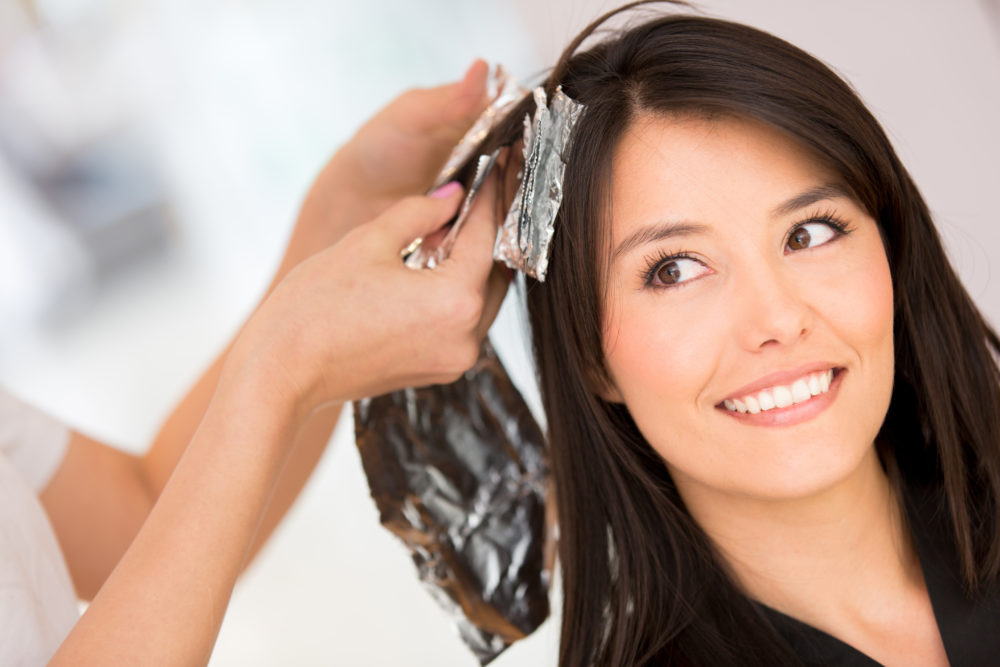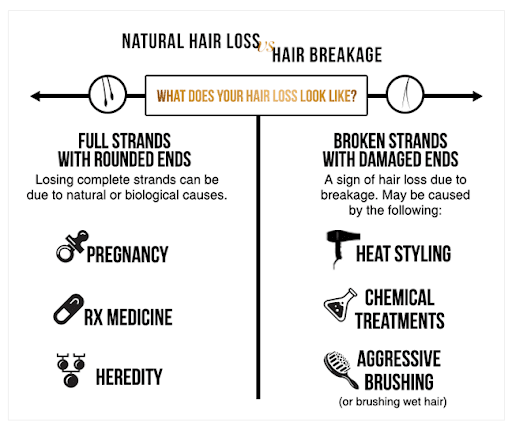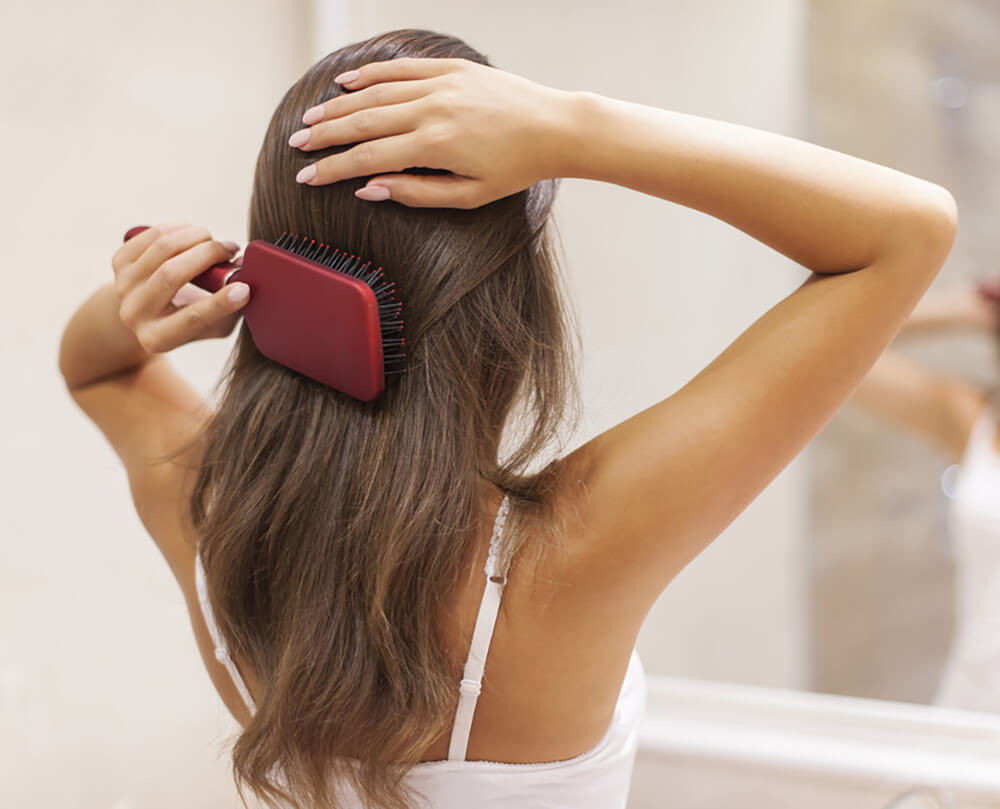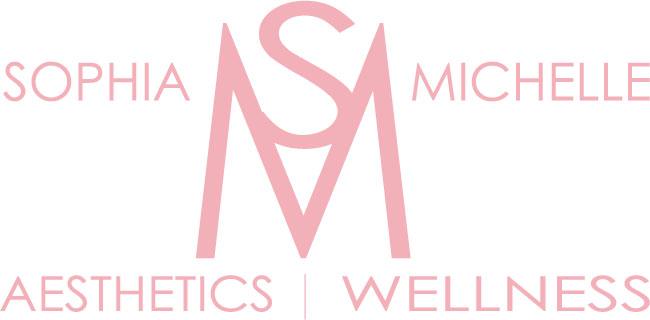
TRAUMA REDUCTION
Coloring
Over the years, coloring hair has become less and less damaging by the advancements in coloring products, and methods. Hair that is currently in an active fall out should not undergo coloring. Those that are suffering from hair thinning should consider only using non-bleaching dyes.
Foils vs. Balayage
Also, methods used to color hair can be a game changer in the reduction of damage on the hair shaft (a portion of the hair that is dead). Foils are one of the harshest methods used to cause extreme damage to fragile hair. Very healthy hair usually can handle intermittent foil treatments when done by an expert stylist. However, we always encourage our clients to receive additional conditioning to ensure the shafts are sealed. Over time the hair will break, and become even more unhealthy. Consider using the method “Balayage,” a non-foil highlighting method, which is heat-free highlighting. A free handed style of highlighting that reduces the frequency of highlighting. In the 1970s, balayage was invented by the French to provide more of a natural sun-kissed highlight. Balayage does require more time at the salon, but the wait is well worth the preservation of your locks, and beautiful sun-kissed results.

Rough/Air Dry
Allow your hair to dry as much as possible before styling is critical to reducing the amount of heat required to style your hair. Attempt to get dressed, and apply make-up before blowing your hair out. Also, do a rough dry before applying the hair dryer over any specific section, this will allow less direct heat onto the hair shafts. Always use hair protection spray before a blowout or heat styling methods.
Blow Drying
One of the worst ways to damage hair is by excessive, and harsh blow drying. Ensuring that the blow dryer does not ever stop on one section is critical to reducing heat damage. A constant movement of the blow dryer over the hair should is vital to preventing damage. When the blow-dryer is permitted to sit on a section of hair for a few seconds’ heat will damage the structure of the hair shaft. If smoke is visualized rising into the air without protectant spray applied, the smoke is the chemically burned particles of the hair shafts. Using protective sprays on the top of the hair before drying the hair is a great option to reduce overheating of the hair, and will also produce smoke, but instead of your hair burning, it is the protectant spray. Another option is to allow the hair to dry as much as possible before drying, or rough drying the hair before a final dry that allows for styling. A smooth constant movement prevents temperatures to rise above 370 degrees, which is the ideal temperature to stay below before damage begins to develop. This single tip can be one of the best adjustments to the styling methods of your hair that can cause extreme damage.

Hair Dryer Top Picks
Dyson Supersonic Hair Dryer
It has an internal thermometer that prevents the dryer from exceeding 300 degrees. Fast dry time (around six minutes for long hair). Perfect for “do it yourself” blowouts for patients suffering from hair thinning.
Protective Spray Top Picks
Oribe Royal Blowout Heat Protectant
The argan- and Morrocan-oil-infused spray speeds up blow-drying while fortifying, brightening, and softening even the most unruly of manes.
Kenra Thermal Styling Spray 19
Provides thermal protection up to 428 degrees, will tame frizz and flyaways and has a genuinely weightless formula ideal for beautiful hair.
TIGI S Factor Flat Iron Spray
A little goes a long way with this heat protection spray that instantly infuses your hair with vitamins A and E to create a silky, soft shine you cannot resist.
Toni & Guy Prep Heat Protection Mist
Kick weak, dull, and damaged hair to the curb with Toni & Guy’s heat protection mist that effectively shields your strands from any and all heat damage caused by hot styling tools. We recommend this spray for wavy or curly hair because it gives your ‘do some extra texture and hold.
Living Proof Restore Instant Protection
Patented Healthy Hair Molecules that protect up to 450°F. Plus, they shield against UV rays and humidity.

Hair Brushes
The life of your hairbrush is not forever. Most hair stylists recommend getting a new brush every 3-6 months depending on the frequency of use. Ultimately the brush can cause harm to your hair after multiple uses, and damage from the heat applied during drying. The bristles’ become injury from the heat and can cause split ends, premature fallout, and more.
Curling/Flattening
Heat creates damage and the more frequent use of heat results in a higher chance of damage. Styling hair is a daily activity, but at the same time, your hair needs the least damaging tools to accomplish your desired result.
Our hair styling tools are continually being advanced; however, it is essential to be wise about your selections, and don’t let infomercials trick you into buying something without your experienced stylist’s recommendations.
Just like before blowing your hair out, remember to use a protectant spray before applying direct heat.
Any curling system that uses steam or mild heat with more prolonged treatment times will result in the least amount of damage. However, today everyone wants an immediate curl, and the times of curlers have come and gone, except for those with unhealthy hair. Traditional curlers maybe the best option for thin and damaged hair.
Tri-Zone, Nano-Tourmaline, and Ceramic Infrared Technology combined in a curler are currently the least heat damaging styling tools on the market. In this area of hair products, the price is high. However, the benefit is worth the reduction of damage, and the cost of future repair.
- Metal curling irons cause positive ions that allow the hair shaft to open, and cause dryness, and damage. Do NOT use them!
- Titanium barreled rods heat evenly, and quickly, but aren’t the best.
- Teflon-coated barrels prevent hair from snagging but wear off over time.
- Ceramic & Tourmaline barreled rods give off negative ions, causing the shaft to seal instead of open, resulting in smooth, sleek, and moist hair.
- Watch for temperature settings. Some will prevent you from reaching high damaging temperatures, others will allow you more temperature options, and our hope for the future is a tool that can alert you just before damage to the hair shaft will occur.
